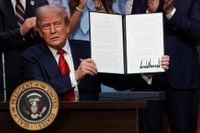On August 18, 2025, the political atmosphere in the United States reached a fever pitch as Democrats rallied in Austin, Texas, to push back against what many are calling an unprecedented assault on American election integrity. The gathering was sparked by a series of maneuvers from former President Donald Trump and his allies, aiming to reshape the nation’s electoral landscape ahead of the 2026 midterm elections. The developments have sent shockwaves through both state and national politics, raising profound questions about the future of democracy in the country.
According to reporting from The Rachel Maddow Show and The Bulwark, the controversy began with Trump’s demand that Republican-controlled states, including Texas, redraw their congressional districts. The objective? To all but guarantee GOP control of Congress for years to come. Trump’s efforts have not been limited to Texas. Vice President JD Vance was recently dispatched to Indiana to pressure the state’s Republican governor into redrawing maps in favor of the GOP, while the White House has reportedly engaged in talks with Republican leaders in Missouri, New Hampshire, South Carolina, and Florida about similar changes. As Politico noted, the stakes could not be higher: these moves are designed to make it “structurally impossible for Democrats to control Congress again.”
But that’s only the beginning. Trump has also sought to lay the groundwork for nullifying or delaying the 2026 midterm elections entirely. His strategy hinges on contesting the validity of the most recent census, which determines congressional districts. By demanding a new census and claiming—without substantiation—that the previous one was tainted by the inclusion of non-citizens, Trump is attempting to delegitimize existing districts. If successful, this could create a pretext for arguing that the current districts are invalid and that congressional elections cannot proceed as planned. As historian and journalist Garrett Graff warned on The Rachel Maddow Show, “This is step one in how we lose free and fair elections.”
The sense of urgency escalated further after Trump’s summit with Russian President Vladimir Putin in Alaska on August 15, 2025. According to The Bulwark, Trump emerged from the meeting with a new resolve to ban mail-in voting and possibly even machine voting, claiming—again without evidence—that both are rife with fraud. Trump announced plans to sign an executive order to this effect, and he made it clear that the idea had Putin’s blessing. “Putin agrees with him that people should not be allowed to vote by mail,” reported The Rachel Maddow Show. The following Monday, Trump publicly declared, “THE MAIL-IN BALLOT HOAX, USING VOTING MACHINES THAT ARE A COMPLETE AND TOTAL DISASTER, MUST END, NOW!!!”
Legal experts and political observers have been quick to point out that Trump’s claims are not only unsupported by evidence but also constitutionally dubious. Under the U.S. Constitution, the responsibility for running elections falls primarily on the states, with Congress holding the power to regulate them—not the president. Yet Trump has asserted, “The States are merely an ‘agent’ for the Federal Government in counting and tabulating the votes. They must do what the Federal Government, as represented by the President of the United States, tells them, FOR THE GOOD OF OUR COUNTRY, to do.” This interpretation flies in the face of established law and has alarmed many across the political spectrum.
Concerns about voter intimidation have also come to the fore. Both The Rachel Maddow Show and The Bulwark highlighted the possibility that Trump could deploy federal law enforcement or National Guard troops to urban centers during the election, ostensibly to “double check” citizenship and prevent fraud. Graff described a scenario in which “urban downtowns will be filled with ICE checkpoints and intimidating National Guard troops to ‘double check’ that only citizens vote.” Such tactics, critics argue, could suppress turnout and undermine the legitimacy of the electoral process.
The redistricting battle in Texas has become a microcosm of the national struggle. State Representative Nicole Collier of Fort Worth made headlines by refusing to comply with Republican leaders’ demands that she sign off on a law enforcement escort before leaving the statehouse. In a statement, Collier declared, “I refuse to sign away my dignity as a duly elected representative just so Republicans can control my movements and monitor me with police escorts.” She called herself a “political prisoner” for resisting what she described as Republican “surveillance protocol.” NBC News reported that such hardball tactics, while extreme, are not without precedent in the state’s rough-and-tumble legislative history.
Meanwhile, the Justice Department has also come under scrutiny. Trump ally Ed Martin, recently appointed as the department’s “weaponization czar,” drew criticism for his aggressive pursuit of New York Attorney General Letitia James. According to The New York Times, Martin not only sent a letter demanding James’s resignation as a “good faith” gesture but also showed up outside her Brooklyn home for a photo op—actions that legal experts say violate Justice Department norms and could compromise any potential case.
Amid these domestic dramas, Trump has also sought to project strength on the world stage. On August 18, 2025, he hosted Ukrainian President Volodymyr Zelensky and a cadre of European leaders at the White House. The meeting, which followed Trump’s controversial summit with Putin, focused on security guarantees for Ukraine, including a massive $100 billion U.S. weapons deal and a $50 billion drone production partnership. While Zelensky and NATO Secretary General Mark Rutte struck an optimistic note, the underlying tensions with Russia remained unresolved. The Financial Times reported that the contours of a possible peace settlement were still unclear, and the Russian foreign ministry reiterated its opposition to the deployment of NATO troops in Ukraine.
Despite the high-profile diplomacy, critics have accused Trump of using such meetings as political theater rather than substantive negotiation. As retired General Mark Hertling observed in The Bulwark, “A principled ceasefire and negotiation require hard work. Trump prefers a fantasy peace.” Still, Zelensky managed to navigate the meeting with diplomatic finesse, offering praise for Trump’s “peacemaking efforts” and even drawing laughter with a quip about the president’s fashion choices.
With the 2026 midterms looming, the stakes could not be higher. Recent polls from Echelon Insights show Vice President JD Vance leading the GOP field, while Democrats remain divided among several contenders. The political landscape is in flux, and the outcome of the ongoing battles over voting rights, redistricting, and election administration may well determine the future of American democracy.
As the dust settles on a tumultuous week in American politics, one thing is clear: the fight over how—and by whom—Americans vote is far from over. The coming months will test the nation’s institutions, its leaders, and, ultimately, its commitment to the principles of free and fair elections.





